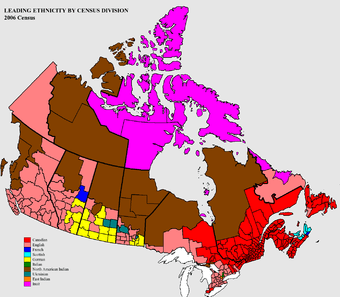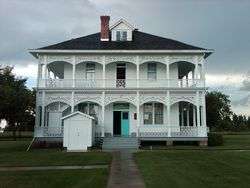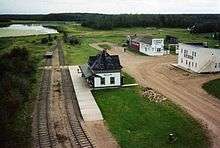Block settlement


A block settlement (or bloc settlement) is a particular type of land distribution which allows settlers with the same ethnicity to form small colonies.
This settlement type was used throughout western Canada between the late 19th and early 20th centuries. Some were planned and others were spontaneously created by the settlers themselves.
The policy of planned blocks was pursued primarily by Clifford Sifton during his time as Interior Minister of Canada. It was essentially a compromise position. Some politicians wanted all ethnic groups to be scattered evenly though the new lands to ensure they would quickly assimilate to Anglo-Canadian culture, while others did not want to live near "foreign" immigrants (as opposed to British immigrants who were not considered foreign) and demanded that they be segregated. At the time Canada was receiving large amounts of non-British, non-French, immigrants for the first time, especially Italians, Germans, Scandinavians, and Ukrainians. The newcomers themselves wanted to settle as close as possible to people with a familiar language and similar customs. The government did not want the west to be fragmented into a few large homogeneous ethnic blocks, however. So several smaller colonies were set up where particular ethnic groups could settle, but these were spaced across the country.[1][2]
Examples of ethnic block settlements in western Canada
African American
- Amber Valley, Alberta
- Breton, Alberta
- Maidstone, Saskatchewan.. Charlow (Shiloh) Baptist Church located north of Maidstone in the rural municipality of Eldon was built in 1912.[3] It was founded by 12 African American families from Oklahoma in 1910.[4]
- Happy Valley, British Columbia
- Saltspring Island, British Columbia
- Wildwood, Alberta
British
- Lloydminster, Saskatchewan/Alberta (temperance colony)
- Walhachin, British Columbia
- Kelowna, British Columbia
Doukhobor


- In Saskatchewan Doukhobors, numbering 7,500, settled in three blocks in the North-West Territories (now in Saskatchewan) from 1899 to 1918. They established 61 communal villages on 773,400 acres (3,130 km2).[5] (Map)
- North Colony (1899-1918) contained 69,000 acres (280 km2) in the Pelly-Arran area settled by 2,400 settlers in 20 communal villages.(Map)
- South Colony (1899-1918) contained 215,010 acres (870.1 km2) in the Canora, Veregin and Kamsack area settled by 3,500 settlers in 30 communal villages. (Map)
- Good Spirit Lake Annex (1899-1918) contained 168,930 acres (683.6 km2) in the Good Spirit Lake and Buchanan area settled by 1,000 settlers in 8 communal villages. (Map)
- Saskatchewan Colony (1899-1918) contained 324,800 acres (1,314 km2) in the Langham, Blaine Lake area settled by 1,500 settlers in 15 communal villages. (Map)
- Sheho and Insinger (1909-1926) contained 1,280 acres (5.2 km2). (Map)
- Kylemore, Saskatchewan (1918-1938) north of Fishing Lake. (Map)
- Kelvinton, Saskatchewan (1921-1938) was west of Kelvinton. (Map)
- British Columbia (1908-1938) (Map)
- Grand Forks-Castlegar-Slocan Valley (1909-1938) was an area of 19,000 acres (77 km2) settled by 8,000 Doukhobors from Saskatchewan in 74 communal villages. (Map)
- Brilliant, British Columbia (1908-1938) on 2,700 acres (11 km2) included 6 communal villages. (Map)
- Ootischenia, British Columbia (1908-1938) on 2,700 acres (11 km2) included 22 communal villages. (Map)
- Champion Creek, British Columbia (1912-1938) on 920 acres (3.7 km2) included 5 communal villages. (Map)
- Glade, British Columbia (1911-1938) on 1,092 acres (4.42 km2) included 11 communal villages. (Map)
- Shoreacres, British Columbia (1912-1938) on 500 acres (2.0 km2) included 3 communal villages. (Map)
- Pass Creek, British Columbia (1909-1938) on 1,760 acres (7.1 km2) included 6 communal villages. (Map)
- Winlaw, British Columbia (1912-1938) on 837 acres (3.39 km2) included 4 communal villages. (Map)
- Alberta
- Cowley-Lundbreck, Alberta (1915-1938) on 13,500 acres (55 km2) included 13 communal villages.(Map)
- Arrowwood-Shouldice-Anastasia, Alberta (1926-1945) (Map)
Dutch
English Canadian
Meaning settlers from Eastern Canada, primarily Ontario, and mostly of British and Irish origins.
French
These include French Canadians from Quebec, French Americans, and Francophones from France, Belgium, and Switzerland
Alberta
- The Bonnyville and St. Paul area (Bonnyville, Cold Lake, Fort Kent, La Corey, Lafond, Mallaig, Saint Lina, Saint Vincent, Therien)
- Lac La Biche and Plamondon, Alberta
- Sturgeon County and Lac Ste. Anne County, Alberta. Specifically the communities of St. Albert, Morinville, Legal, Rivière Qui Barre, Villeneuve, Pickardville, and around the shores of Lac Ste. Anne and Lac La Nonne.
- Smokey River bloc settlement (Donnelly, Falher, Alberta, Girouxville, Guy, Jean Côté, Mac Lennan, Marie-Reine, Saint Isidore, Tangent).
British Columbia
Manitoba
- Rat River settlement (Saint Labre, Saint Pierre Jolys, Saint-Malo)
- Red River settlement (Saint Boniface, Saint Vital, Saint Norbert, Saint Germain, Cartier, La Salle, Saint Adolphe, Glenlea, Sainte Agathe, Tourond, Aubigny, Dufrost, Saint Jean Baptiste, Sainte Elizabeth, Saint Joseph, Letellier)
- Seine River settlement (Dufresne, Giroux, Ile des Chênes, La Broquerie, Lorette, Marchand, Richer, Saint Raymond, Sainte Anne des Chênes, Sainte Genevieve)
- Whitehorse plain settlement (Elie, Fannystelle, Saint Eustache, Saint François Xavier, Saint Laurent, Saint Ambroise)
Saskatchewan
- Cantal-Bellegarde settlement (Alida, Antler, Bellegarde, Cantal, Redvers, Storthoaks, Wauchope)
- Delmas bloc settlement (Cochin, Delmas, Edam, Jackfish Lake, Vawn)
- Duck Lake settlement (Domremy, Duck Lake, Saint Isidore de Bellevue, Saint Louis)
- Gravelbourg bloc settlement[6] (Gravelbourg, Lafleche, Mazenod, Meyronne).
- Leoville-Debden bloc (Bapaume, Big River, Debden, Laventure, Leoville, Spiritwood, Victoire)
- Ponteix settlement (Cadillac, Lac Pelletier, Pambrun, Ponteix, Vanguard)
- Prud'homme Vonda settlement (Prud'homme, Saint Denis, Vonda)
- Willow Bunch bloc settlement (Assiniboia, Fife Lake, Lisieux, Little Woody, Maxstone, Rockglen, Saint Victor, Verwood, Willow Bunch)
- Wood mountain bloc (Ferland, Glentworth, Fir mountain, Wood mountain)
- St Hubert, Saskatchewan
Francophone Métis settlements
Some French settlements were founded by Francophone Métis from the Red River settlement in Manitoba. Many began as Métis hivernants buffalo hunting camps from the 1840s to the 1870s.[7][8]
- Lebret, Saskatchewan (St-Florent mission) 1866 and Val Qu'Appelle 1860s
- Touchwood Hills 1860s
- St-Laurent-Grandin Métis settlements 1868-1876
- Wood Mountain, Saskatchewan 1870s and Willow Bunch, Saskatchewan
- Lac Pelletier, Saskatchewan/ Vallée Ste-Claire 1870s
- Cypress Hills, Saskatchewan 1870s
- la-Prairie-Ronde near Dundurn, Saskatchewan 1850s
- Frenchman Butte, Saskatchewan 1880s
- Cochin, Saskatchewan 1880s
- Delmas, Saskatchewan 1880s
- St-Lazare 1880s
- Val Marie, Saskatchewan
German
- around Regina, Saskatchewan
- Medicine Hat, Alberta - Dunmore, Alberta
- Bruderheim, Alberta - Josephburg, Alberta
- Hilda, Alberta - Schuler, Alberta
- Hussar, Alberta
- Langenburg, Saskatchewan and Hohenlohe[9]
- Pierceland, Saskatchewan
- Paradise Hill, Saskatchewan
- Leader, Saskatchewan
- Burstall, Saskatchewan - Richmound, Saskatchewan
- Eatonia, Saskatchewan
- Strasbourg, Saskatchewan (New Elsass German Colony)[9]
- Macklin, Saskatchewan
- Lemberg, Saskatchewan
- Neudorf, Saskatchewan
- Heinsburg, Alberta - Lindbergh, Alberta
- Sudeten Germans[9]
- St. Joseph's Colony (Katharinental) (1886-1904)[10][11]
- Davin, Saskatchewan
- Rastadt, Saskatchewan
- Kronau, Saskatchewan
- Vibank, Saskatchewan
- Odessa, Saskatchewan
- Kendall, Saskatchewan
St. Peter's Colony
.jpg)
St. Peter's Colony[12] founded in 1903 in Saskatchewan was 4,662 square kilometres (1,800 square miles) in size.[13] It included 50 townships; townships 35 to 40, ranges 18 to 22, and townships 37 to 41, ranges 23 to 26 of the Dominion Land Survey west of the 2nd Meridian.[14] 8,000 settlers had arrived in the colony by 1910[15] and by 1930 it was home to 18,000 Roman Catholics. Most were German Catholics.[16] Between 1903 and 1925 parishes were established at Leofeld, Muenster, Fulda, Marysburg, Annaheim, Englefeld, Watson, Lake Lenore, Bruno, Humboldt, Burr, St. Gregor, Pilger, St. Benedict, Dana, Carmel, Cudworth, Middle Lake, Peterson and Naicam.
St. Joseph's Colony (Josephstal)
St. Joseph's Colony (Josephstal) (1905)[17][18][19] Villages in this Saskatchewan colony included Adanac, Biggar, Broadacres, Cactus Lake, Carmelheim, Cavell, Cosine, Denzil, Donegal, Evesham, Grosswerder, Handel, Kelfield, Kerrobert, Landis, Leipzig, Luseland, Macklin, Major, Onward, Pascal, Phippen, Primate, Revenue, Reward, Salvador, Scott, Tramping Lake, Unity, Wilkie and Wolfe.
Italian
Hungarian

- Esterhazy, Saskatchewan (Kaposvar Colony 1886)
- Kipling, Saskatchewan
- Prince Rupert, British Columbia (from 1956 on)
Hutterite

Hutterites are German-speaking Anabaptists who live in communal agricultural colonies. They have 188 colonies in Alberta, 117 in Manitoba, 72 in Saskatchewan and 3 in British Columbia. These Canadian colonies began with 18 colonies founded in 1919.[20][21] Map
Jewish


- Hirsch, Saskatchewan
- Qu'Appelle or Lipton, Saskatchewan (1901)
- Cupar, Saskatchewan (1901)
- Bender Hamlet or Narcisse, Manitoba (1903)
- La Macaza, Quebec (1904)
- Ste-Sophie, Quebec (1904)
- Sonnenfeld colony, near the hamlet of Oungre, Saskatchewan (1905)[22][23][24]
- Edenbridge, Saskatchewan (1906), also known as Yid'n Bridge (Jews' Bridge)[25]
- Trochu, Alberta (1906)
- Rumsey, Alberta (1906)
- Pine Ridge, Manitoba (1907)
- Birds Hill, Manitoba (1911)
- Camper, Manitoba or New Hirsch, Manitoba (1911)
- Eyre, Saskatchewan (1910)
- Montefiore, Saskatchewan (1911)
- Rosetown, Saskatchewan (1911) [near the town of the same name]
Mennonite
_1.378_MANITOBA%3B_RAT_RIVER_MENNONITE_RESERVATION.jpg)
- The Manitoba government set aside the Mennonite East Reserve now in the Rural Municipality of Hanover and the Mennonite West Reserve now in the Rural Municipality of Rhineland and the Rural Municipality of Stanley for the new Russian Mennonite immigrants coming to the province beginning in 1875.[26] Most spoke Mennonite Low German.[27] (Map)
- Saskatchewan settlements[28] (Map)
- Rosthern, Saskatchewan 1891-1892,[29] Eigenheim, Laird, Waldheim, Tiefengrund.
- Osler, Saskatchewan/Hague, Saskatchewan 1895[29]
- Langham, Dalmeny, Borden, Mennon, Hepburn
- Herbert and Swift Current, Saskatchewan 1904[29]
- Herschel, Fiske, Kindersley and Superb 1920s
- Hanley and Dundurn districts
- Early Alberta settlements began in La Crete, Alberta and Didsbury, Alberta 1901[29][30]
- Early British Columbia settlements began in Yarrow, British Columbia and Abbotsford, British Columbia 1911[29][31]
Mormon

Cardston founded in 1887 was the first Latter-day Saint settlement in Alberta. [32]
Portuguese
Romanian
Scandinavian
Swedish
- Hilltop, Manitoba and Scandinavia, Manitoba in the Rural Municipality of Clanwilliam 1885
- New Stockholm, Saskatchewan 1886[33]
- Percival, Saskatchewan
- Wadena, Saskatchewan
- Camrose, Alberta
- Waterville, Quebec
Danish
- New Denmark, New Brunswick
- Danevirke Redvers, Saskatchewan
- Cape Scott, British Columbia
Finnish
- Thunder Bay, Ontario
- New Finland, Saskatchewan
- Turtle Lake, Saskatchewan
- Sointula, British Columbia
- Webster's Corners, British Columbia (F)
Norwegian

- Skaro, Alberta
- Birch Hills, Saskatchewan
- Torquay, Saskatchewan
- Ibsen, Saskatchewan
- Lake Alma, Saskatchewan
- Norge, Saskatchewan
- Lillestrom, Saskatchewan
- Rose Valley, Saskatchewan
- Simmie, Saskatchewan
- Leroy, Saskatchewan
- Norwegian Cove, Saskatchewan
- New Norway, Alberta
- Forestburg, Alberta
- Camrose, Alberta
- Oyen, Alberta
- Hagensborg, British Columbia
- Pemberton, British Columbia (originally Agerton)
Icelandic



- Vatnabyggd was an Icelandic settlement of about 2,000 square kilometres in Saskatchewan south of Fishing Lake and the Quill Lakes. By 1911 it had attracted over 1,600 Icelanders.[34][35] Vatnabyggd included the settlements of Kristnes, Saskatchewan (1903), Dafoe (1905), Kandahar (1905), Wynyard (1904), Mozart (1903), Elfros (1903), Leslie (1907), Holar, Saskatchewan (1905), Mount Hecla, Saskatchewan (1904) and Foam Lake (1892). (Map)
- Near Churchbridge, Saskatchewan were the settlements of Thingvalla-Logberg and Vallar
- New Iceland (Nja Ísland) (1875-1897) was located on the southwest shore of Lake Winnipeg in Manitoba. The Rural Municipality of Gimli and the Rural Municipality of Bifrost are within the old settlement area. New Iceland contained the settlements of Gimli, Riverton, Hnausa and Arborg.[26] (Map)
- Other Icelandic settlements in Manitoba included Baldur, Erickson, Geysir, Manitoba, Glenboro, Lakeview, Manitoba, Lundar, Morden and Reykjavik
- Markerville, Alberta
Ukrainian
Ukrainian settlements with approximate date of founding (Map):
- Edna-Star, Alberta (1892). Founded by the original Ukrainian Canadian pioneers Iwan Pylypow and Wasyl Eleniak, this is the oldest and largest of the Ukrainian block settlements and was once considered the largest Ukrainian community in the world outside Eastern Europe. It is now the world's largest eco-museum, called Kalyna Country, which includes Sturgeon County, Thorhild County, the County of St. Paul No. 19, the County of Vermilion River, the County of Two Hills No. 21, the County of Minburn No. 27, Beaver County, Lamont County, and Strathcona County, and many of the neighbouring towns and cities.[36][37] (Map)
- Manitoba settlements included Stuartburn, Manitoba (August 1896), Dauphin, Manitoba (September 1896). Interlake, Manitoba (June 1897), Shoal Lake, Manitoba (April 1899) and Whitemouth, Manitoba.[38]
- Saskatchewan settlements were in the Montmartre-Candiac area (1895–96), the Yorkton–Canora–Preeceville area in eastern Saskatchewan, the Rosthern–Yellow Creek–Cudworth area north of Saskatoon and the Radisson–Hafford–Whitkow area east of North Battleford.[39]
Old Ritualists (Old Believers)
See also
References
- ↑ "Atlas of Saskatchewan (Ethnic Bloc Settlements map)". Retrieved 2014-05-31.
- ↑ "Ethnic Bloc Settlement in the Prairies". 1989. Retrieved 2014-05-31.
- ↑ "Charlow (Shiloh) Baptist Church and Cemetery". Retrieved 2013-11-19.
- ↑ "Shiloh Baptist Church Cemetery". Retrieved 2013-11-19.
- ↑ "Doukhobor Reserves in Saskatchewan, 1899-1918". Retrieved 2014-06-14.
- ↑ "Francophone land settlement in southwestern Saskatchewan by Beckey Hamilton" (PDF). Retrieved 2014-03-23.
- ↑ "Atlas of Saskatchewan (French and Francophone Métis Settlements)". Retrieved 2014-04-06.
- ↑ John Welsted (1 January 1996). The Geography of Manitoba: Its Land and Its People. Univ. of Manitoba Press. p. 89. ISBN 978-0-88755-375-2.
- 1 2 3 "German Saskatchewan Genealogy Roots". Retrieved 2014-05-28.
- ↑ "St. Joseph's Colony, Katharinental Colony, Kronau-Rastadt, and Odessa (1886-1904)". Retrieved 2014-05-28.
- ↑ "Historical Sketch of St. Peter's Parish and the Founding of the Colonies of Rastadt, Kathrinenthal and Speier". Retrieved 2014-05-28.
- ↑ "St. Peter's Colony Map". Retrieved 2014-05-28.
- ↑ "Encyclopedia of Saskatchewan (GERMAN SETTLEMENTS)". Retrieved 2012-12-28.
- ↑ Jerome Weber O.S.B. (1949). "St. Peter's Abbey 1903-1921" (PDF). CCHA Report. Canadian Catholic Historical Association. 16: 37–49. Retrieved 2015-01-26.
- ↑ "Colony Beginnings(p.6)". Retrieved 2013-01-06.
- ↑ "The German Catholics of St. Peter's Colony: 1903-1930 By Paul Paproski, OSB" (PDF). Retrieved 2012-12-12.
- ↑ "St. Joseph's Colony - Index Page". Retrieved 2014-05-28.
- ↑ "St. Joseph's Colony: 1905 - 1930". Retrieved 2014-05-28.
- ↑ "Towns & Villages Of St. Joseph's". Retrieved 2014-05-28.
- ↑ "Regional index of Hutterite colonies". Retrieved 2014-06-23.
- ↑ "Mapping Hutterite Colony Diffusion in North America". 26 June 2012. Retrieved 2014-06-23.
- ↑ Feldman, Mottie (January 2002). "Sonnenfeld Colony: A Piece of Saskatchewan History". Retrieved 18 May 2016.
- ↑ Feldman, Mottie (January 2002). "Pioneer Stories from Sonnenfeld Colony". Retrieved 18 May 2016.
- ↑ "S.W.20-2-15-W.2nd, Sonnenfeld, Saskatchewan. [textual record] – 1975". Canadian Jewish Heritage Network. Retrieved 18 May 2016.
- ↑ "Story of Saskatchewan's Jewish farmers goes to national museum". CBC News. 12 July 2013. Retrieved 18 May 2016.
- 1 2 "An Experiment in Immigrant Colonization: Canada and the Icelandic Reserve, 1875-1897 by Ryan Christopher Eyford (map page 4)" (PDF). Retrieved 2014-05-28.
- ↑ "Krahn, Cornelius and Adolf Ens. (1989). Manitoba (Canada). Global Anabaptist Mennonite Encyclopedia Online.". Retrieved 2014-06-07.
- ↑ "Rempel, John G. and Otto Driedger. (1990). Saskatchewan (Canada). Global Anabaptist Mennonite Encyclopedia Online.". Retrieved 2014-06-07.
- 1 2 3 4 5 "Mennonite Historical Society of Canada (history/migrations to Canada)". Retrieved 2014-05-28.
- ↑ "Gingerich, Melvin, C. Lorne Dick and Reynold Sawatzky. "Alberta (Canada)." Global Anabaptist Mennonite Encyclopedia Online.". Retrieved 2014-06-07.
- ↑ "Klassen, Cornelius F., John M. Klassen and Richard D. Thiessen. "British Columbia (Canada)." Global Anabaptist Mennonite Encyclopedia Online.". Retrieved 2014-06-07.
- ↑ "Mormon News Room: Facts and Statistics (Canada-Alberta)". Retrieved 2014-06-19.
- ↑ New Stockholm Lutheran Church
- ↑ "Vatnabyggd: An Icelandic Settlement in Saskatchewan". Retrieved 2014-05-28.
- ↑ "Major Icelandic Settlements in America". Retrieved 2014-05-28.
- ↑ "A map of the Ukrainian bloc settlement of east central Alberta". University of Alberta. 2007. Retrieved 2014-06-17.
- ↑ "Internet Encyclopedia of Ukraine (Alberta)". 2009. Retrieved 2014-07-26.
- ↑ "Internet Encyclopedia of Ukraine (Manitoba)". 2010. Retrieved 2014-07-26.
- ↑ "Internet Encyclopedia of Ukraine (Saskatchewan)". 2008. Retrieved 2014-07-26.
Further reading
- Alan Anderson, "Ethnic Bloc Settlements," Encyclopedia of Saskatchewan (2006) online
- Paul Robert Magocsi, ed. Encyclopedia of Canada's Peoples (1999)
External links
- The Atlas of Saskatchewan provides a map of the entire province showing all major ethnic bloc settlements.
- Government of Alberta's Heritage Department's page about the history of the Ukrainian settlements in East-Central Alberta
- Ukrainian Cultural Heritage Village is a living history village 50 km east of Edmonton, Alberta which focuses on the experiences of Ukrainian immigrants and the block settlements.
- Multicultural Canada (Encyclopedia of Canada's Peoples)
